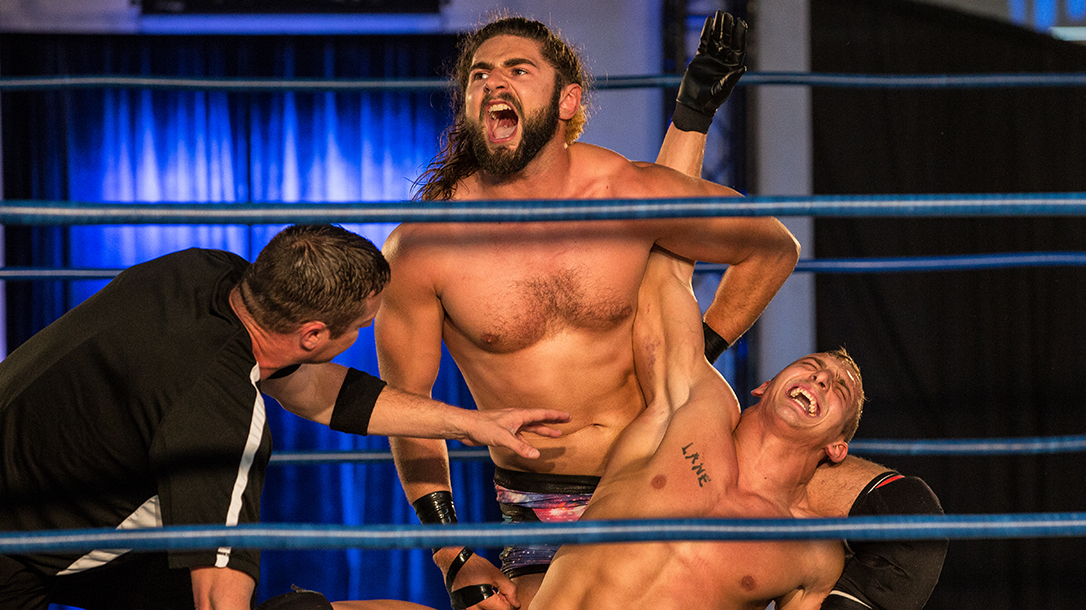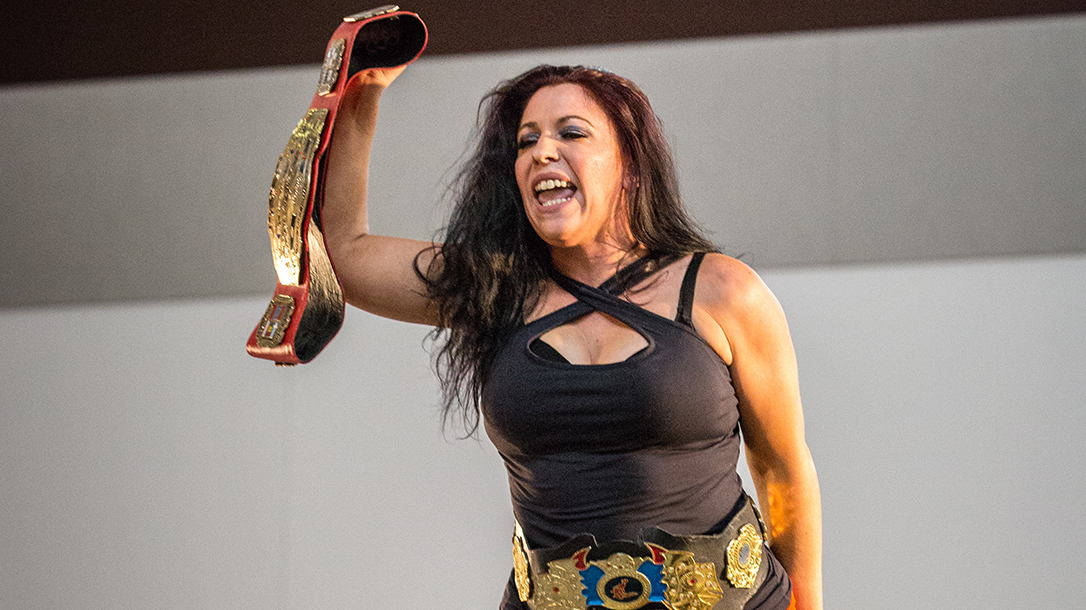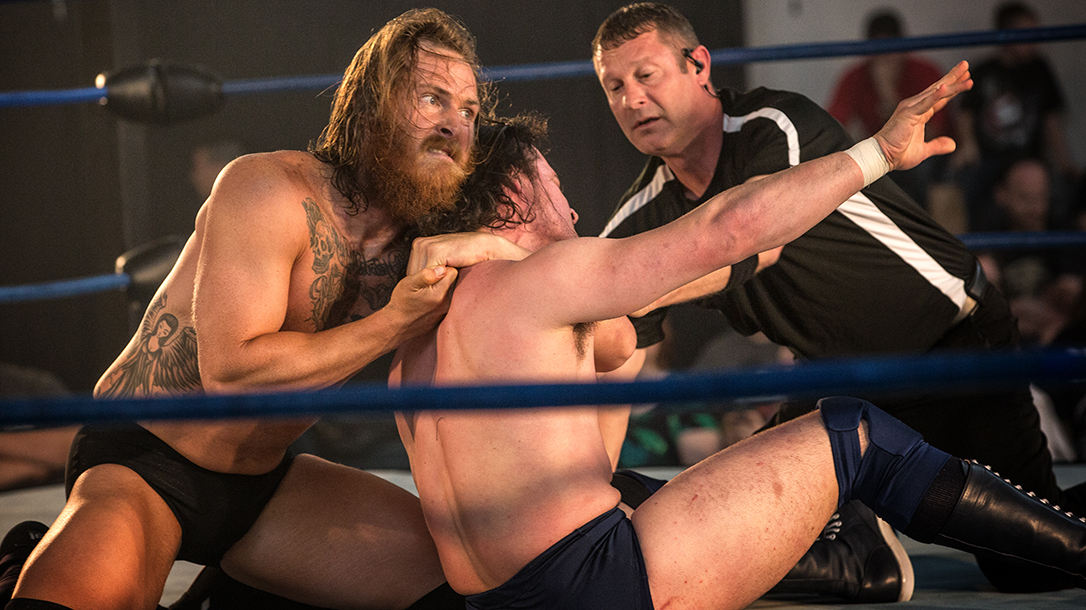Before we get started, let’s just get this out of the way. Pro wrestling is NOT fake. That’s right, I said it. Now, I know the majority of you are raising the bullshit flag right now, but hear me out. Pro wrestling is scripted. It’s entertainment — the same entertainment you see on the movie screen, except the action is live and real. The slams, the collisions and the blood are all real and part of the script to make the spending of your hard-earned dollars worth it. These men and women are actors. Actors that do their own stunts. The sacrifices they make to entertain the masses are astronomical, both physically and mentally in the West Coast Wrestling Connection.
The West Coast Wrestling Connection
When we decided to run an article about professional wrestling, our initial thought was to go to the big leagues. We contacted the WWE development center and started putting the wheels in motion for a visit. Then it dawned on me that these wrestlers have already made it. Their years of grinding to get to where they are today are behind them. I was afraid we wouldn’t get a true, inside look at what it really takes to make it in this industry. I cancelled our tickets to Orlando and decided to head west instead.
There are dozens of independent leagues across our great nation, but one really caught our attention. The West Coast Wrestling Connection is one of the longest-running organizations in the Pacific Northwest, and they invited us to attend one of their live monthly TV tapings in Portland, Oregon.
Getting a behind-the-scenes look at this sport is a rarity. Just like magicians, pro wrestlers never want to reveal all their tricks. The CEO of WCWC, Jeff Manning, took us in immediately and gave us a briefing. While he gave us full access behind the curtain, Manning asked us to honor the “wrestling code,” and that out of respect for the profession, we not give the world a complete “tell-all” of the inner workings of a show. We humbly agreed, and the day began.
Like many of you, I grew up a die-hard fan of wrestling. I think I was lucky enough to see the golden age of the sport firsthand. The 80s were a special time, and the personalities that came out of that era cemented its existence for decades to come. Watching legends such as Ric Flair, Dusty Rhodes, Randy Savage and the Iron Sheik made me fall in love with not only the non-stop action, but the showmanship as well. Now I would get to see the future icons of this sport on their way toward evolving into superstars.
Showtime
Our day began in the early morning at a National Guard armory south of Portland. Today, the WCWC was going to film four episodes of their weekly broadcast, and there was a ton of work to do before the first bell rang. The night prior, Jeff Manning and Director of Marketing, R.J. Jillette, made countless trips to the airport as their wrestlers flew in from all corners of the country. Erik Baeden, the Director of Talent Development, worked through the evening fine-tuning storylines to be ready for the next morning’s briefing. While all this was going on, dozens of crewmembers prepared the stage to be ready for the 1:00 p.m. curtain call.

I was amazed by how much had to be done in so little time. As soon as the wrestlers arrived at the facility, WCWC co-founder Pat Kelley grabbed the film crew and started mapping out the promo spots that needed to be shot prior to show time. Pat, who has been in this business since the 1960s, was as cool as a block of ice. He has worked hundreds of shows throughout his career and has even promoted events with legends such as the Fabulous Moolah. Pat’s work with the athletes developing these short, one-minute spots was amazing. WCWC broadcasts these clips in between matches to help to build wrestlers’ stories. Whether it is a new champion bragging about his recent performance or a backstage brawl between rivals, these tiny snippets of propaganda are crucial for developing storylines for fans to follow.
While all this was going on, TV Director D-Lo Brown was preparing for his meeting with the wrestlers. Yes, I said D-Lo Brown. For those who follow wrestling, you know the name. D-Lo spent over six years in the WWF and even held the WWE Intercontinental Championship belt at one point in his career. His 30 years in the sport make him the perfect man to have the weight of the show on his shoulders. When D-Lo Brown speaks, everyone listens.
After the promo spots had been filmed and the venue set was built, it was time for the coordination brief. All the wrestlers, referees, managers, production crew and commentators gathered in this closed-room meeting. Here, they mapped out every match with the cast down to the last minute. This process was amazing to watch. They really didn’t get into move-by-move details; this is for the wrestlers and refs to figure out. D-Lo authoritatively ran this meeting and once the work was done, he adjourned — no questions asked.
For the next hour, the wrestlers coordinated their matches as the final preparations ensued. Mik Drake, an East Coast-based wrestler, discussed with his opponent how he was going to “put him over” during their performance. Mik is what they call a “heel,” or a bad guy. He is wrestling a newcomer to the WCWC, and it is his job to get the crowd to fall in love with the good guy (or “babyface,” in industry terms). This is where a wrestler’s second skillset comes into play. Highflying moves only go so far; wrestlers need to be able to sell the drama of the match to bloodthirsty fans.
“I love getting under fans’ skins,” Mik explained. “Sometimes I will single out someone in the crowd and start egging them on, and other times, all it takes is a sinister look in a fan’s direction and they tee off on me. It’s so badass.” Drake has been perfecting his bad-guy persona for over a decade, and he also works fulltime as an environmental lawyer out of New York City. “I put in 50 hours a week at a law firm and then travel the country each weekend wrestling in multiple organizations,” he explained.

It’s that type of dedication that really showed during his bout. Every move looked legit and you could feel the anger rising within the crowd as he dominated most of the match. But Mik did what he was asked to do. The final minutes of the contest were dedicated to making the newcomer look like a hero, and by the time the ref slapped the mat for the third time, the new babyface was a crowd favorite in the WCWC.
Name Of The Game Is Teamwork
What really took me by surprise was the amount of coordination it takes to complete each match. In the back of each venue there sits a production truck. Inside this vehicle are D-Lo Brown and a few other vital members of the crew. Watching every camera angle, they are the central nervous system of the promotion. One guy feeds the commentators information about the wrestlers and upcoming events. Another guy talks to the cameramen, instructing them on which angles to get. And then there is D-Lo, who barks instructions to the referee.
It’s D-Lo’s job to keep the talent informed about how the matches are going. He talks directly to the referee (who wears an earpiece) and gives coordinating instructions on the fly. If the crowd is not into the match, D-Lo will notice the lack of interest and make adjustments. He also gives the refs time hacks to make sure everything is on point. Working within “TV time” requires a nuanced understanding and manipulation of the flow of a match.
Once they receive instructions, it’s the refs’ job to pass them along to the wrestlers. Ever see the official get in front of a wrestler and chew him out for doing something “illegal”? Most of the time refs are actually passing along info or time calls. The art of this is in how the audience never hears these conversations. To the crowd, referees appear to be letting wrestlers know that eye gouging, etc. won’t be tolerated in their squared circles. It’s an amazing process to watch.
While all this is going down, Jeff Manning — better known by his ring persona, “Morty Lipschitz” — is working the arena. At the beginning of the show, he comes out and warms up the crowd. He is well known among the masses and the chants of “Morty Sucks!” fill the hall. First, he enters the ring and begins insulting the patrons. It’s a brilliant move because it gets the crowd’s blood boiling. Then, right before they are ready to throw him over the top rope, he starts giving away money. I’ve never seen so many middle fingers turn into waving hands screaming, “Pick me!” in my life. The event is full of energy now. Morty has done his job.
Final Bell
Today’s event lasts over five hours, and the die-hard patrons eventually all leave with smiles on their faces. Not only did they get to see championship belts change hands, they also enjoyed specialty matches featuring midgets and female superstars. It was a win-win for everyone in attendance.
But afterwards behind the curtain, the wrestlers nurse their wounds. The amount of injury these athletes endure is frightening. I watched some of the more seasoned wrestlers walk around with permanent limps and crooked spines. There is no doubt that this business takes its toll on a human body.

Wrapping up the day, Pat gets everyone together and gives a motivational speech that seems straight out of an 80s football movie. In a world of low paychecks and red-eye travel, this man knows how to keep spirits high. He reminds everyone about why they do it and the impact they have on the young fans who need someone positive to look up to. They perform to take people out of the harsh realities of their everyday lives and to give them something to cheer about before heading back to the real world. They do it because they are entertainers.
Will some of these wrestlers end up in the WWE? Unfortunately, it’s highly doubtful. Do they have the grit, the skill and the mental fortitude to be there? Absolutely, but it’s a sheer numbers game in the end. Only a very small percentage of professional wrestlers make it to the top. What I took away from this whole experience was these athletes’ determination to pursue a dream. These young men and women won’t settle for the cubicle life. They want to inspire and entertain. They want to be pinned high up on some kid’s wall, so when that child falls asleep at night staring at their posters, they know they are having a positive impact upon the lives of youth — this is the gold belt truly worth holding above their heads.
If you’re a fan of wrestling like us, check out the West Coast Wrestling Connection and make sure to listen to our podcast, Skillset Live! We always spotlight fighters that live the “alpha lifestyle” in our magazine and on our show!






















